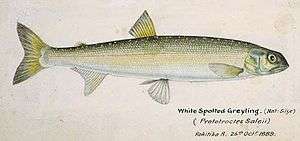New Zealand grayling
The New Zealand grayling (Prototroctes oxyrhynchus), also known as upokororo, pokororo, paneroro, and kanaekura (Māori), is an extinct smelt of the genus Prototroctes, which was found only in lowland rivers and streams of New Zealand.[3][4] They were an amphidromous species—spawning in freshwater streams and developing to maturity in saltwater.[5] Their length was between 20 and 40 cm.
| New Zealand grayling | |
|---|---|
 | |
| Scientific classification | |
| Kingdom: | |
| Phylum: | |
| Class: | |
| Order: | |
| Family: | |
| Subfamily: | Prototroctinae |
| Genus: | |
| Species: | P. oxyrhynchus |
| Binomial name | |
| Prototroctes oxyrhynchus Günther, 1870 | |
Though abundant through the early colonial period, by the 1870s their population had declined.[6] The last known specimen was caught in the late 1920s to early 1930s. Deforestation and predation, competition and disease from introduced trout likely led to the New Zealand grayling's extinction.[1] The impact of introduced diseases from trout has a parallel in Australia, where utterly immense fish kills of the closely related Australian grayling were caused by introduced strains of Saprolegnia shortly after widespread trout stocking commenced (Saville-Kent, 1888; Cadwallader, 1996). Tasmanian populations of Australian have never recovered from this blow and remain relatively vestigial.
In 1951, some years after the last sighting, the species was given full legal protection by the Freshwater Fisheries Regulations, the only New Zealand native freshwater fish to be protected.[7]
In August 2018 the New Zealand Department of Conservation classified the New Zealand grayling as "Extinct" under the New Zealand Threat Classification System.[2]
References
- Cadwallader, P.L. (1996) Overview of the Impacts of Introduced Salmonids on Australian Native Fauna. Australia Nature Conservation Agency, Canberra.
- Saville-Kent, W, 1888. On the acclimatisation of the salmon (Salmo salar) [and exotic trout species] in Tasmanian waters, and upon the reported disease at the breeding establishment on the River Plenty. Papers and Proceedings of the Royal Society of Tasmania 1887: 54–66.
| Wikimedia Commons has media related to New Zealand grayling. |
- West, D; David, B. & Ling, N. (2014). "Prototroctes oxyrhynchus". IUCN Red List of Threatened Species. 2014: e.T18384A20887241. doi:10.2305/IUCN.UK.2014-3.RLTS.T18384A20887241.en.
- Dunn, Nicholas R.; Allibone, Richard M.; Closs, Gerard P.; Crow, Shannan K.; David, Bruno O.; Goodman, Jane M.; Griffiths, Marc; Jack, Daniel C.; Ling, Nicholas. Jonathan M. Waters and Jeremy R. Rolfe. "Conservation status of New Zealand freshwater fishes, 2017" (PDF). New Zealand Threat Classification Series. Department of Conservation. 24: 8.
- "Out of the frying pan: Into oblivion". New Zealand Geographic. Retrieved 2020-05-03.
- "Waikato Taniwharau". Science Learning Hub. Retrieved 2020-05-03.
- Cruz, Tess; Torres, Armi G. "Prototroctes oxyrhynchus Günther, 1870 New Zealand grayling". Fishbase. Retrieved 21 January 2019.
- McDowall, R.M. "Grayling". www.niwa.co.nz. Retrieved 21 January 2019.
- Mitchell, Charlie (14 February 2018). "The enduring mystery of our only protected freshwater native fish". Stuff. Retrieved 24 September 2018.

